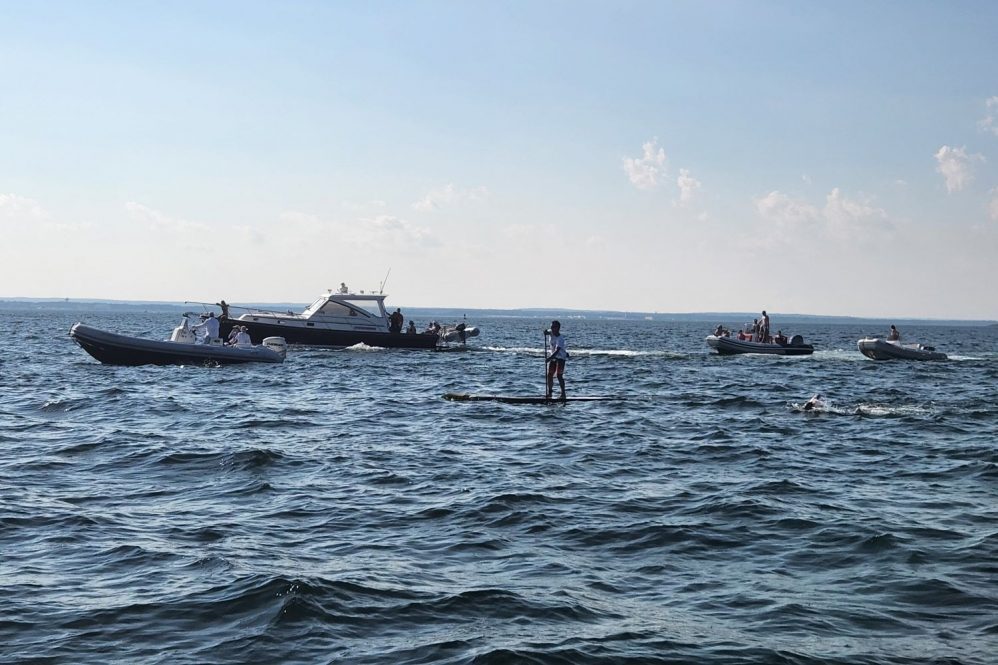On July 22, 2022, Ben Tuff swam 25 miles from Providence, RI to Jamestown, RI. Coached by UConn’s Korey Stringer Institute (KSI), Tuff teamed up with the organization to help gain valuable research on the physiological effects that ultra-marathon swims have on the human body. Soon audiences around the country will be able to experience his journey and the work of his support team in a new documentary being released nation-wide on June 13, 2023.
As a recovering alcoholic, Tuff sought to bring attention to addiction while also raising money for the non-profit environmental group Clean Ocean Access. He completed this historic swim in just under 15 hours. Tuff became the first person in history to complete both achievements and most recently became the first swimmer to swim to the length of Narragansett Bay.

But this wasn’t the first time Tuff used his skills in the water to raise awareness and funds for a good cause.
In August 2020, Tuff swam around Conanicut Island, a 21-mile distance raising $54,000. In 2021, he swam from Block Island to Jamestown, completing the 19-mile event in 9 hours and 19 minutes while facing the threats of cold water and sharks. He was able to raise over $106,000. Thanks to the generosity of friends, family, and lovers of the ocean, Tuff has raised more than $250,000 to date for Clean Ocean Access.
These feats gained the attention of award-winning documentary maker, Matt Corliss. Together, Corliss and Tuff produced the movie to share his story of addiction recovery and elite endurance.
“It’s crazy to think that I barely knew how to swim before I went through treatment for alcohol addiction,” says Tuff. “My sponsor suggested I try the sport. I may not be the greatest swimmer but I thrive on taking on these big challenges to get attention for things that matter, like our environment and treatment for those who are struggling.”
KSI’s associate director of athlete performance and safety David Martin organized many aspects of Tuff’s record-breaking swim in 2022. KSI, an institute within the College of Agriculture, Health and Natural Resources, provides research, education, advocacy, and consultation to maximize performance and safety for anyone who participates in taxing physical activities, like athletes, laborers, and warfighters.
During his pre-swim training, Tuff averaged almost 20,000 yards per week from January to July. In the weeks leading up to the event, Tuff reached over 50,000 yards of swimming and swam for 9 hours straight. His training included a mix of speed sets in the pool, muscular endurance sets using pull buoys and paddles, and open water swimming working at longer intervals near his critical swim speed pace.
Ahead of the swim, Martin and Christianne Eason, KSI president of sport safety, developed the critical Emergency Action Plan (EAP) to prepare for anything that Tuff might need. The EAP included a map of Tuff’s route with docks designated for use in the event of an emergency. Along the 24-mile stretch of coast, local fire departments, police departments, and EMS services were contacted and routinely updated about Tuff’s swim. KSI was in constant contact with the Coast Guard to ensure that major shipping channels were avoided and other logistics were addressed. Two trained medical staff were present on the boat following Tuff for the entirety of his swim.
The KSI team also assessed the physiology of an ultra-marathon swim by collecting data during Tuff’s swim. Martin worked with Robert Huggins, KSI president of research, to measure fluid consumption, caloric intake, core temperature, stroke rate, pace, and many other variables. They found that Tuff consumed over 7 liters of fluid and stayed at an average of 50 strokes per minute during the entirety of the almost 15-hour swim. His core temperature also remained moderately cool during the swim; however, after the swim he had a fever through the night.
“This experience perfectly exemplifies KSI’s mission to not only conduct cutting-edge research, but also to provide potentially life-saving services to athletes pushing themselves to the limit,” says Martin. “Ben took on something extraordinary, and we were honored to have the chance to help him succeed.”
This work relates to CAHNR’s Strategic Vision area focused on Enhancing Health and Well-Being Locally, Nationally, and Globally.
Follow UConn CAHNR on social media



